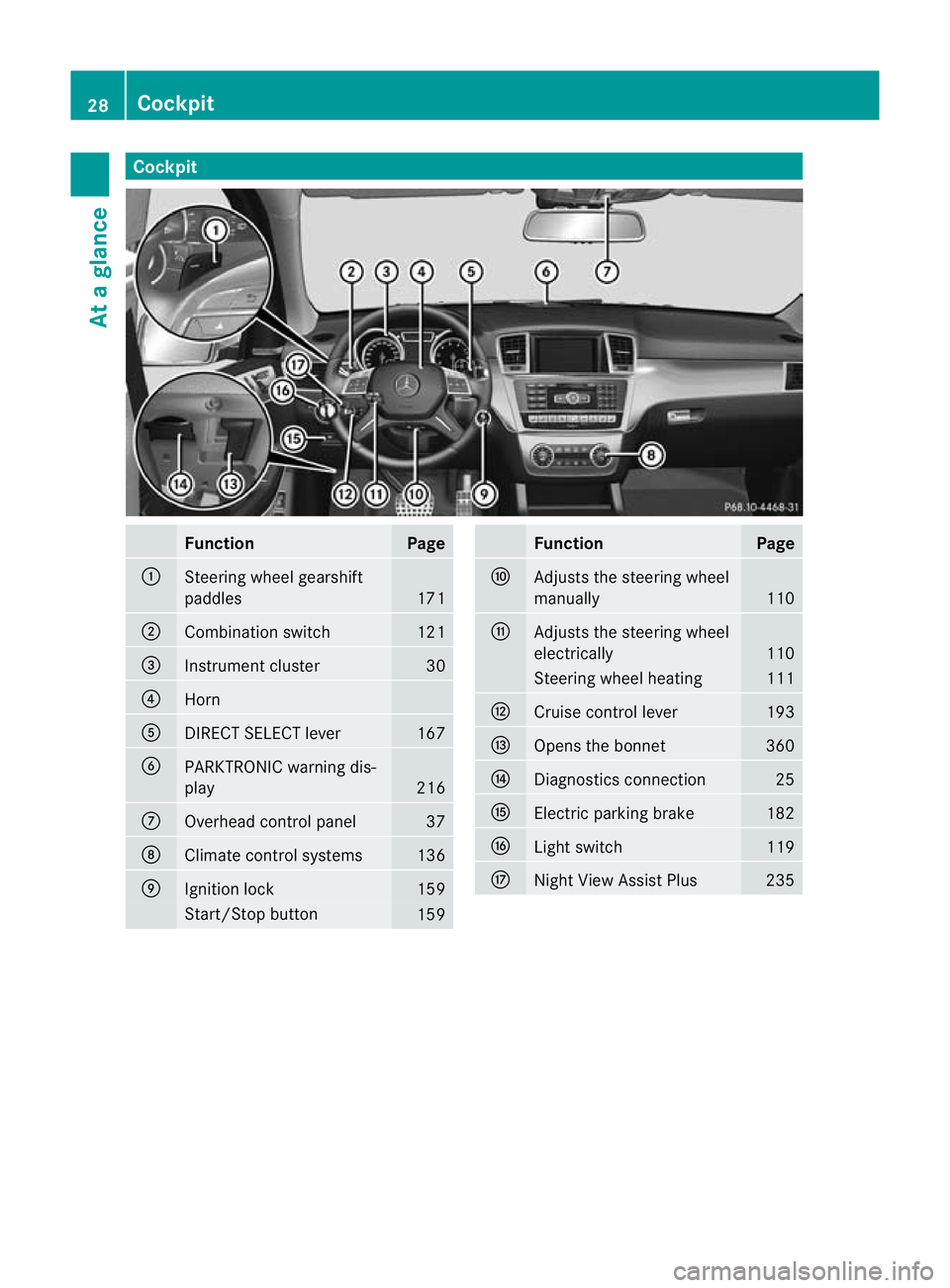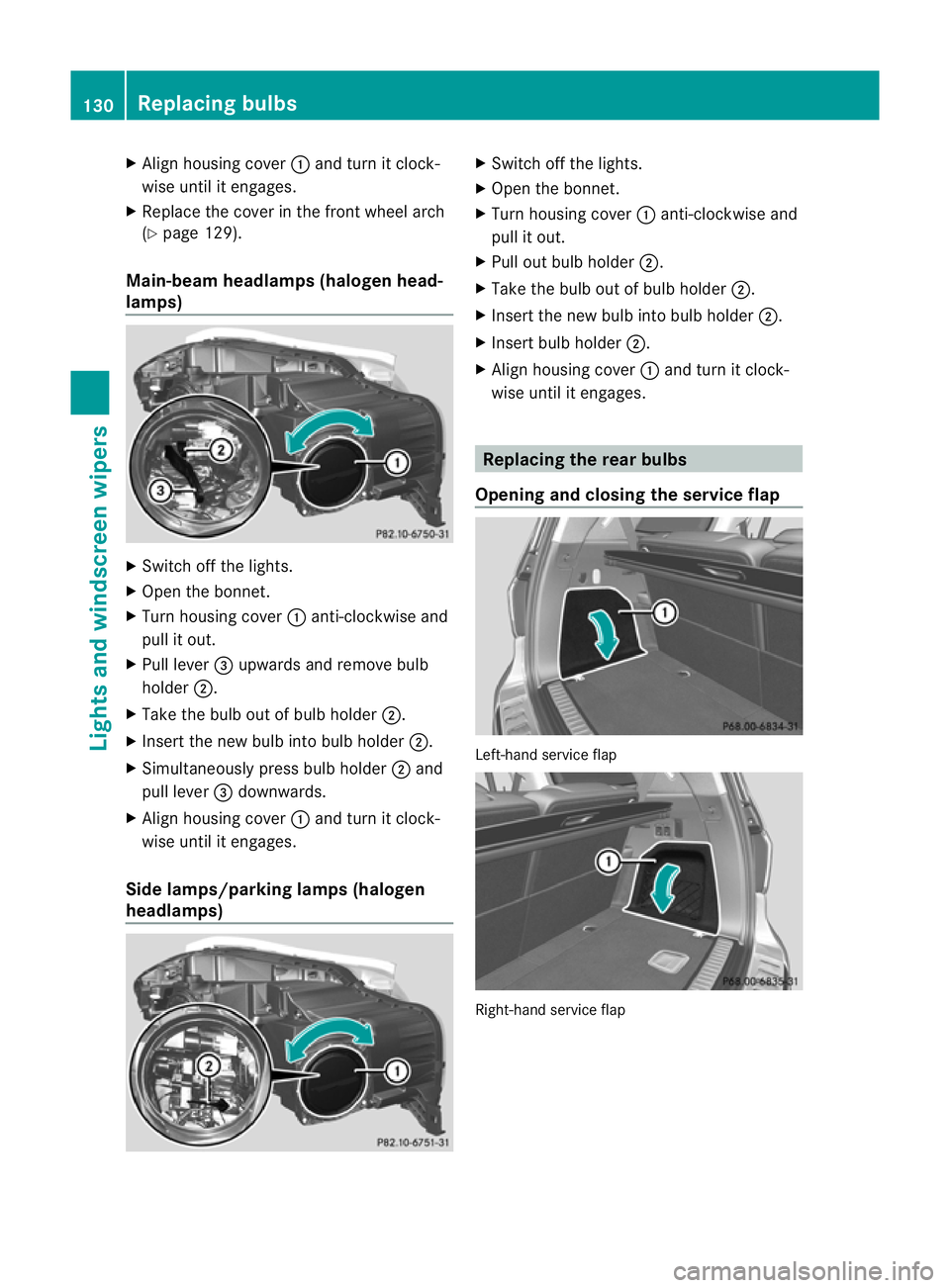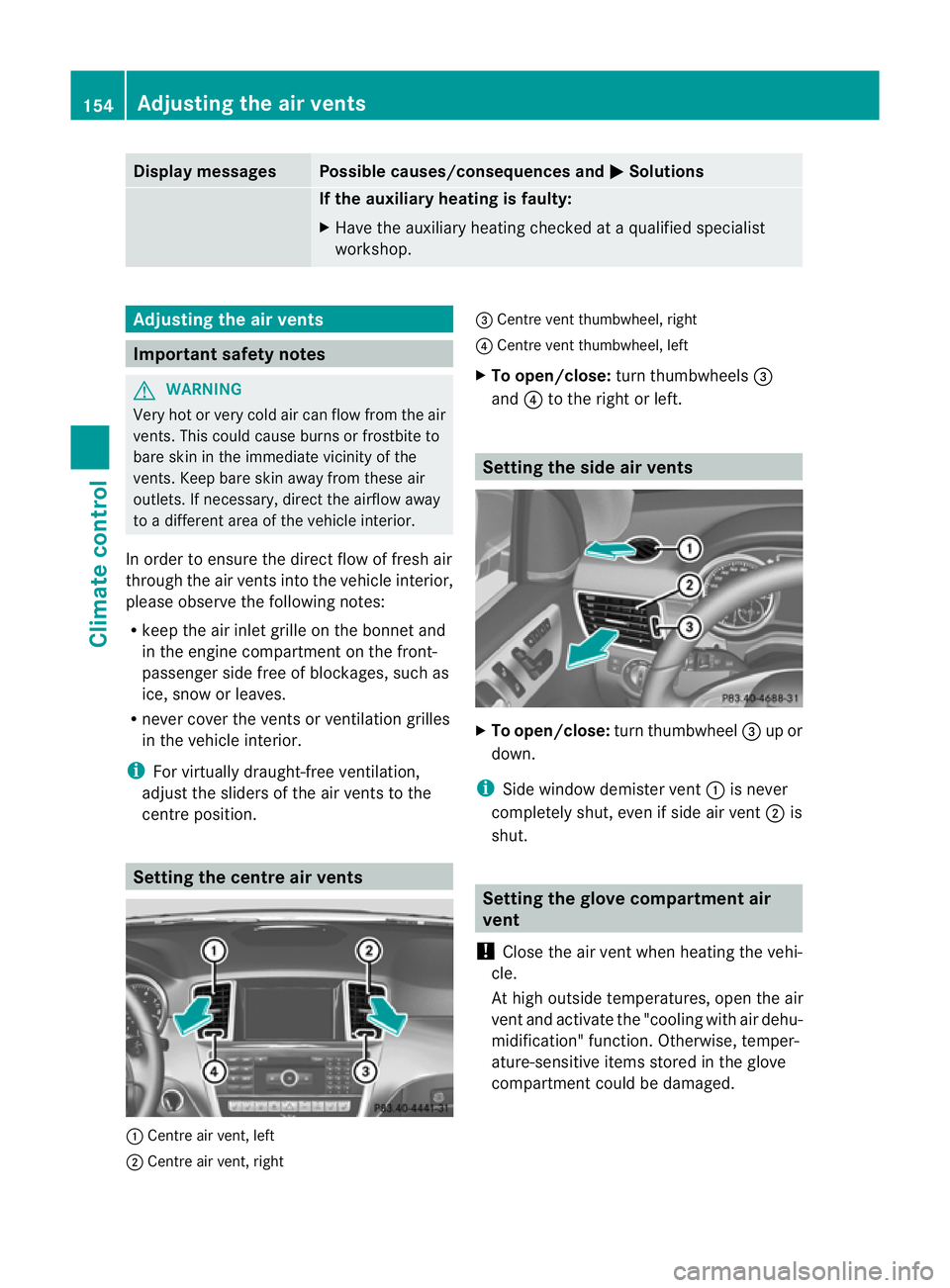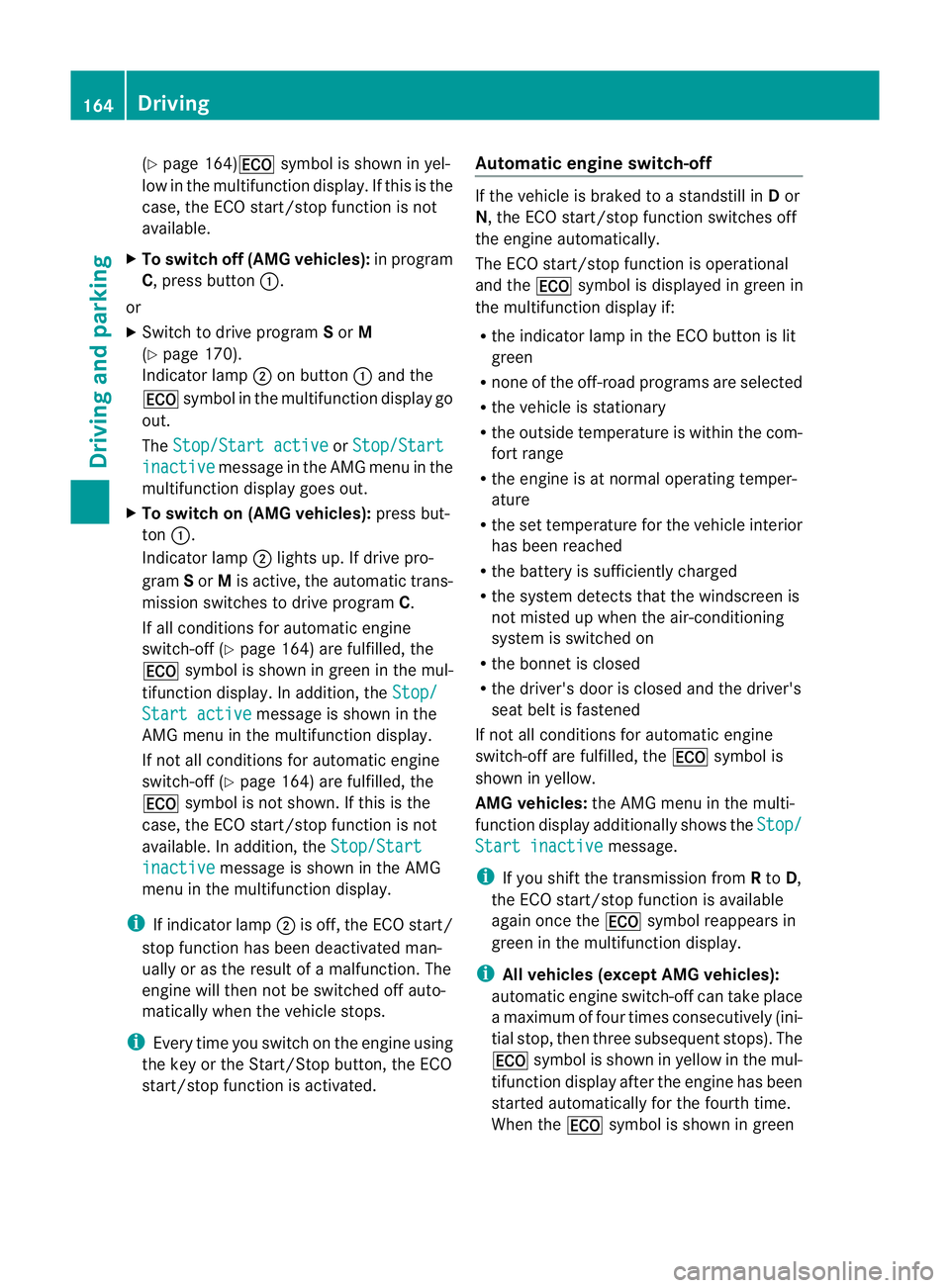2012 MERCEDES-BENZ GL SUV bonnet
[x] Cancel search: bonnetPage 31 of 441

Cockpit
Function Page
:
Steering wheel gearshift
paddles
171
;
Combination switch 121
=
Instrumen
tcluster 30
?
Horn
A
DIRECT SELECT lever 167
B
PARKTRONI
Cwarning dis-
play 216
C
Overhead con
trol panel 37
D
Climat
econtrol systems 136
E
Ignition lock 159
Star
t/Stop button 159 Func
tion Page
F
Adjusts th
esteering wheel
manually 110
G
Adjusts th
esteering wheel
electrically 110
Steering wheel heating 111
H
Cruise control lever 193
I
Open
sthe bonnet 360
J
Diagnostics connection 25
K
Electric parking brake 182
L
Ligh
tswitch 119
M
Night View Assist Plus 23528
CockpitAt
ag lance
Page 32 of 441

Function Page
:
Overhead con
trol panel 37
;
PARKTRONI
Cwarning dis-
play 216
=
Combination switch 121
?
Instrument cluster 30
A
Horn
B
DIRECT SELECT lever 167
C
Steerin
gwheel gearshift
paddles 171
D
Nigh
tView Assist Plus 235
E
Light switch 119
F
Diagnostic
sconnection 25 Function Page
G
Open
sthe bonnet 360
H
Electric par
king brake 182
I
Ignitio
nlock 159
Star
t/St op button 159
J
Adjusts the steerin
gwheel
manually 110
K
Adjusts the steeri
ngwheel
electrically 110
Steerin
gwheel heati ng 111
L
Cruise control lever 193
M
Climate control systems 136Cockpit
29Atag lance
Page 45 of 441

nor do they provid
eanindicatio nofairbag
deployment.
The vehicle may be deformed significantly,
e.g. the bonnet or the wing, withou tanairbag
being deployed. This is the case if only parts
which are relatively easily deformed are affec-
ted and the rat eofdeceleration is not high.
Conversely, airbags may be deployed even
though the vehicle suffers only minor defor-
mation. This is the case if, for example, very
rigid vehicle part ssuch as longitudinal body
members are hit, and sufficien tdeceleration
occu rsas aresult.
i The fron tbelt tensioners can only be trig-
gered if the seat belt tongues on the front
seats are cor rectly engage dinthe seat belt
buckles.
i Not all airbags ar edeployed in an acci-
dent .The different airbag system swork
independently of each other.
How the airbag system work sisdeter-
mined by the severity of the accident detec-
ted, especially the vehicle deceleration or
acceleration, and the apparent type of acci-
dent:
R head-on collision
R side impact
R overturn Airbags
Important safety notes G
WARNING
Airbags provide additional protection; they
are not, however ,asubstitute for seat belts.
Observe the following notes to reduce the risk
of serious or even fatal injury caused by airbag
deployment:
R all vehicle occupants –inparticular ,preg-
nant women –must wear their seat belt
correctly at all times and lean back against
the backrest, which should be posi tioned
as close to th evertical as possible. The head restraint must support th
eback of the
head at about eye level.
R always secur echildren less than
1.50 mtall or under 12 years of age in suit-
able child restraint systems.
R all vehicle occupant smust select aseat
position that is as far away from the airbag
as possible. The driver' sseat position must
allow the vehicle to be driven safely .The
driver's chest should be as fa raway from
the centre of the driver' sairbag cover as
possible.
R move the front-passenger seat as far back
as possible .This is especially important if
you hav esecured achild in achild rest raint
system on the front-passenger seat.
R vehicle occupant s–inparticular ,children
–m ust not lean their heads into the area of
the window in which the sidebag/window-
bag is deployed.
R rearward-facing child restraint systems
must not be fit tedtot he front-passenger
seat unless the front-passenger airbag has
been disabled. On the front-passenger
seat, the front-passenger airbag is disabled
if ac hild rest raint system with atrans-
ponde rfor automatic child seat recognition
is fit tedtot he front-passenger seat in a
vehicle equipped with automatic chil dseat
recognition. The 4PASSENGE RAIRBAG
OF Findicator lamp must be continuously
lit.
If the front-passenger sea tofyour vehicle
does not have automatic child seat recog-
nition ,oryour rearward-facing child
rest raint system does not have atrans-
ponde rfor automatic child seat recogni-
tion ,children must be secured in achild
rest raint system on asuitable seat in the
rear. If you secure aforward-facing child
rest raint system to the front-passenger
seat, you must move the front-passenger
seat as far back as possible.
R make sure there are no heavy or sharp-
edged objects in the pockets of clothing. 42
Occupant safetySafety
Page 74 of 441

Anti-
thefts ystems Im
mo biliser
X To activate wit hthe ke y:remove the key
from the ignition lock.
X To activat ewith KEYLESS-GO: switch the
ignitio noff and open th edriver's door.
X To deactivate: switch on the ignition.
Th eimmobil iser prev ents you rvehicle from
being star tedw ithout the correct key.
When leaving the vehicle, always take the key
with you and lock the vehicle. Anyone can
start the engin eifavalid key has been left
inside the vehicle.
i The immobiliser is alway sdeactiva ted
when you start the engine. ATA (Anti-Theft Alarm system)
X
To prime: lock the vehicle with the key or
KEYL ESS-GO.
Indicator lamp :flashes .The alar msys-
tem is primed after approximately
15 seco nds.
X To switch of fwith the key: unlock the
vehicle using the key.
or
X Inser tthe key int othe ignition lock.
X To switch of fwith KEYLESS-GO: unlock
the vehicle using KEYL ESS-GO.
or
X Pres sthe Start/Stop button on the dash-
board. The key must be insid ethe vehicle. Av
isual and audible alarm is triggered if the
alarm system is prime dand you ope n:
R ad oor
R the vehicle with the emergency key ele-
ment
R the tailgate
R the bonnet
X To turn th ealarmo ff wit hthe ke y:press
the % or& button on the key.
Th ea larm is switche doff.
or
X Insert the key into the ignition lock.
Th ea larm is switche doff.
X To sto pthe alarm using KEYLESS-GO:
gras pthe outside door handle. The key
must be outside th evehicle.
The alar misswitched off.
or
X Press the Start/Stop button on the dash-
board. The key must be inside the vehicle.
The alarm is switched off.
The alarm is not switched off ,even if you
close the open door that ha striggered it, for
example. Tow
-away protection
Function An audible and visual alarm is trigge
redify our
vehicle' sangle of inclination is altered while
tow-away protection is primed. Thi scan occur
if the vehicle is jacked up on one side, for
example.
Activating X
Make sure that: Anti-theft systems
71Safety Z
Page 133 of 441

X
Align housing cover :and turn it clock-
wise unti litengages.
X Replace the cove rinthe front wheel arch
(Y page 129).
Main-beam headla mps(halogen head-
lamps) X
Switch off the lights.
X Open the bonnet.
X Turn housing cover :anti-clockwise and
pull it out.
X Pull lever =upwards and remov ebulb
holder ;.
X Take the bulb out of bulb holder ;.
X Insert the new bulb into bulb holder ;.
X Simultaneously press bulb holder ;and
pull lever =downwards.
X Align housing cover :and turn it clock-
wise until it engages.
Side lamps/parking lamps (halogen
headlamps) X
Switch off the lights.
X Open the bonnet.
X Turn housing cover :anti-clockwise and
pull it out.
X Pull out bulb holder ;.
X Take the bulb out of bulb holder ;.
X Insert the new bulb into bulb holder ;.
X Insert bulb holder ;.
X Align housing cover :and turn it clock-
wise until it engages. Replacing the rear bulbs
Openin gand closing th eservice flap Left
-hand service flap Right-hand service flap130
Replacin
gbulbsLight sand windscreen wipers
Page 135 of 441

5
¯ Continuous wipe, fast
B í Single wipe
C î To wipe with washer fluid
X Turn the key to position 1or 2in the ignition
lock (Y page 159).
X Turn the combination switc htothe corre-
sponding position.
In the ÄorÅ position, the appropriate
wipin gfrequency is se tautomatically accord-
ing to the intensity of the rain. In the Å
posi tion, the rain sensor is mor esensitive
than in the Äposition, causin gthe wind-
screen wiper stowipe mor efrequently. Switc
hing th erearw indow wiper on/
off Combi
nation switch
: è Rear windo wwiper switch
2 b To wipe with washer fluid
3 ITo switc honintermitten twiping
4 0To switc hoff intermittent wiping
5 ô To wip ewith washer fluid
X Turn the key to position 1or 2in the ignition
lock (Y page 159).
X Turn switch :on the combination switch
to the correspondin gposition.
When the rea rwindow wiper is switched on,
the icon appears in the instrumen tcluster. Replacing th
ewiper blades
Important safety notes G
WAR
NING
The wipe rarms could start moving and cause
an injury if you leave the windscreen wipers
switche don.
Remove the key from the ignition lock before
replacing the wipe rblades.
! Never open the bonnet if awindscreen
wiper arm has been folded away from the
windscreen.
Never fold awindscreen wiper arm without
aw iper blade back ont othe windscreen/
rea rwindow.
Hold the windscreen wiper arm firmly when
you change the wiper blade. If you release
the windscreen wiper arm without awiper
blade and it falls ont othe windscreen, the
windscreen ma ybedamaged by the force
of the impact.
Mercedes-Benz recommends that you have
the wiper blades changed at aqualified
specialist workshop.
! To avoid damaging the windscreen wiper
blades, mak esure that you touc honly the
wipe rarm of th ewindsc reen wiper.
Replacing th ewindscreen wiper blades Removing th
ewiper blades
X Remov ethe key fr om theignition lock.
X Fold the wiper ar maway fro mthe wind-
screen. 132
Windscreen wipersLights and windscreen wipers
Page 157 of 441

Displa
ymessages Possible causes/consequences and
M Solutions
If th
eauxiliar yheating is faulty:
X Hav ethe auxil iaryh eatin gchecked at aqualified specialist
workshop. Adjusting th
eair vents Important safet
ynotes G
WARNING
Ver yhot or ver ycold ai rcan flo wfromt he air
vents. This coul dcause burns or frostbite to
bare skin in the immediate vicinity of the
vents. Keep bare skin away from these air
outlets. If necessary, direct the airflow away
to ad ifferent area of the vehicle interior.
In order to ensure the direct flow of fresh air
through the air vent sinto the vehicl einterior,
please observe the following notes:
R keep the air inlet grill eonthe bonnet and
in the engin ecompartmen tonthe front-
passenger side free of blockages, such as
ice, snow or leaves.
R never cover the ven tsor ven tilation grilles
in the vehicle interior.
i For virtually draught-free ventilation,
adjust the sliders of the air vent stothe
cen treposition. Setting the centre air vents
:
Centre air vent, left
; Centre air vent, right =
Centre ven tthumbwheel, right
? Centre ven tthumbwheel, left
X To open/close: turnthumbwheels =
and ?to the right or left. Setting th
eside air vents X
To open/close: turnthumbwheel =up or
down.
i Side window demister vent :is never
completely shut, even if side air vent ;is
shut. Setting th
eglove compartment air
vent
! Close the air vent when heating the vehi-
cle.
At high outside temperatures, open the air
vent and activate the "cooling with air dehu-
midification" function. Otherwise, temper-
ature-sensitiv eitems stored in the glove
compartmen tcould be damaged. 154
Adjusting th
eair ventsClimat econtrol
Page 167 of 441

(
Y page 16 4)¤ symbol is shown in yel-
low in the multifu nction display .Ifthis is the
case ,the ECO star t/stop function is not
available.
X To switch of f(AMG vehicles): in program
C,p ressbutton :.
or
X Switc htod rive program Sor M
(Y page 170).
Indi cator lamp ;on button :and the
¤ symbol in the multifunction display go
out.
The Stop/Star tactive or
Stop/Start inactive message in th
eAMG men uinthe
multifunction displa ygoes out.
X To switch on (AM Gvehicles): press but-
ton :.
Indicator lamp ;lights up. If drive pro-
gram Sor Mis active, the automatic trans-
mission switches to drive program C.
If all conditions for automatic engine
switch-of f(Ypage 16 4)are fulfilled, the
¤ symbol is shown in green in the mul-
tifunction display. In addition, the Stop/Star
tactive message is show
ninthe
AMG men uinthe multifunction display.
If not all condition sfor automatic engine
switch-of f(Ypage 16 4)are fulfilled, the
¤ symbol is not shown. If this is the
case, the ECO start/stop function is not
available. In addition, the Stop/Startinactive message is shown in the AMG
menu in the multifunction display.
i If indicator lamp ;is off, the ECO start/
stop function has been deactivated man-
ually or as the result of amalfunction .The
engin ewill then not be switched off auto-
matically when the vehicle stops.
i Ever ytime you switch on the engine using
the key or the Star t/Stop button, the ECO
start/stop function is activated. Automatic engine switch-off If the vehicle is braked to
astandstill in Dor
N,t he ECO start/stop func tion switches off
the engin eautomatically.
The ECO start/stop function is operational
and the ¤symbol is displayed in green in
the multifunction displa yif:
R thei ndicato rlamp in the ECO button is lit
green
R none of the off-road programs are selected
R the vehicle is stationary
R the outside temperature is within the com-
fort range
R the engine is at normal operating temper-
ature
R the set temperature for the vehicle interior
has been reached
R the battery is sufficiently charged
R the system detects that the windscreen is
not misted up when the air-conditioning
system is switched on
R the bonnet is closed
R the driver' sdoor is closed and the driver's
seat belt is fastened
If not all condition sfor automatic engine
switch-of fare fulfilled ,the ¤ symbol is
shown in yellow.
AM Gvehicles: the AMG menu in the multi-
func tion display additionally shows the Stop/ Star
tinactive message.
i If yo ushift the transmission from Rto D,
the ECO start/stop func tion is available
again onc ethe ¤ symbol reappear sin
green in the multifunction display.
i All vehicles (except AM Gvehicles):
automatic engine switch-off can take place
am aximum of four times consecutively (ini-
tial stop, then three subsequent stops). The
¤ symbol is shown in yellow in the mul-
tifunction displ ayafter the engine has been
started automatically for the fourth time.
When the ¤symbol is shown in green 164
DrivingDriving and parking